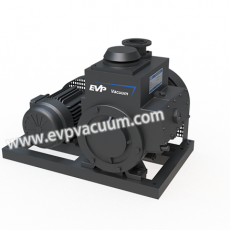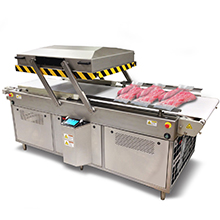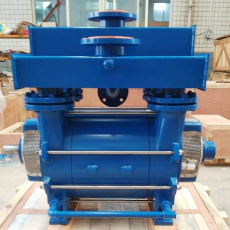Rotary vane pumps are used in Vacuum Plastic Molding
Vacuum Plastic Molding(Also be called vacuum forming) is a molding method in which a plastic sheet is heated to a viscoelastic state, and then vacuum suction is applied to the mold surface, and the desired shape is obtained after cooling. The vacuum suction molding process is as follows: heating the plastic sheet to a certain temperature, and then vacuuming the mold, forming a negative pressure through the small holes on the mold, the sheet is attached to the outer wall of the mold under atmospheric pressure, and then formed after cooling. Now, widely used in plastic packaging, lighting, advertising, decoration and other industries.

The essence of vacuum forming is the behavior of stretching and deformation when the sheet is heated (usually radiant heating) to soften, so that there is a certain relationship between tension and elongation. To study and master this relationship is the vacuum forming technology the key is.
The vacuum forming machine unit is composed of upper and lower heater, temperature controller, bearing plate, pressing frame, vacuum pump, vacuum chamber, mold temperature control machine, cooling device, etc., among which the temperature regulation has manual (potentiometer) and automatic (PLC) two methods. After configuring the computer, it is more convenient to debug parameters and store all kinds of parameters. When producing a part of any type, just call the parameters out.
Note that the upper limit of the heating temperature is the lowest range of the raw material melting temperature (one-time molding). In this way, the raw material molecules can flow freely without changing the shape given by one-time processing and molding. Secondly, not only the morphological remnants before the blister are left in appearance, but there are also remnants in the material itself. Since the deformation during blister is the thermal movement of the material molecules (segment movement), part of the energy required for deformation is stored in the raw material. When the molded product (the sheet after a single molding such as PVC, ABS, PP) is stored Etc.), it will return to its original shape when reheated, and exhibit the reducing power. The power that is frozen and restored like this is a feature of the blister molded product.

Vacuum plastic molding process
Convenient to understand, here we use the ABS resin vacuum molding to analyze.
1.Clamping
The pressing frame fixed the ABS plate on the bearing plate to ensure that the edge of the plate does not leak when blowing bubbles. The length and width of the pressing frame are determined according to the size of the plate. The types are:
Flat pressing, the whole pressing frame is assembled from steel plate with a thickness of 20mm, which is characterized by high flatness and plane strength at the bottom.The disadvantage is that it is necessary to use milling, planing and other processing equipment to reprocess, and the production cost is high. When the bearing plate is bent and deformed, it can not be evenly pressed to the plate.
Point pressure, like a comb shape, press the plate and fix it on the angle steel with countless screws to form a frame. The screw spacing is about 50mm. The pressing plate should be pointed, or the connecting rod mechanism can be pushed by a cylinder to press the plate tightly like a two-handed piano. Divided into arrays, the structure is simple, and can make up for the shortcomings of flat pressing.
2.Heating
Heating method
There are infrared heating, resistance wire heating, etc. The current advanced heating is the patented metal heating tile of Japan’s Asano Company. The heating time is extremely short. It only takes 10s to rise from normal temperature to 500°C, so debugging is more convenient than other heating tiles. At the same time, the upper and lower surfaces are generally heated at the same time, in order to make the upper and lower surfaces of the material evenly heated. The adjustment of heating temperature is mainly determined by the shape and thickness of the parts. When the effect of temperature adjustment is not obvious, other methods can be used, such as sticking aluminum foil on the edge of the press box to reflect the transformation to the position where the plate needs to be heated. The heating unit (infrared heating tile) is as small as possible. Each heating tile is individually controlled and the temperature is controlled accurately.
Heating temperature
The ABS sheet is softened to a molding temperature of 127℃~180℃, which varies with the degree of vacuum and the shape of the product. When rapid vacuum forming low-draw products, the molding temperature is about 140℃, and the temperature of deep-extended draft products is about It is 150°C, and the highest molding temperature is 170°C only for larger and complex products. In addition, the heating power is prone to voltage changes, and it is necessary to configure a regulated power supply to ensure a constant temperature.
Heating time
Because the sheet is pure and thick, the heating time is longer, but the heating time should correspond to the heating temperature, the temperature is low, the heating time is long; the temperature is high, the heating time is short. It cannot be simply understood as shortening the heating time and improving production efficiency by increasing the heating temperature. Because the heating temperature of the material has a certain range, it is lowered, and the heating time is longer, which is good for the uniform heating of the material. This is extremely effective for thick plates with a thickness of more than 3mm, especially those with slight moisture.
3.Forming
The heated and softened plate is stretched by blowing, and then placed on a blister mold. The plate is sealed with the mold, and vacuum is drawn through the vacuum hole on the mold to form a negative pressure, and the plate is attached to the surface of the mold.
Bubbling: Compressed air is blown out through the vacuum cavity, and the heated plate is stretched evenly like a balloon. The height of the blowing is generally 2/3 of the height of the mold.
Auxiliary molding: Some products have complex shapes, so it is necessary to configure an auxiliary press frame to pre-form the plate.
Vacuum degree: Usually the vacuum degree is controlled above 0.1MPa. In order to extract the air in the mold in a short time, a larger volume vacuum tank is required.
Vacuum holes: Generally, the diameter is 0.5~2mm. The size and number of vacuum holes are related to the thickness of the plate. If the plate thickness is less than 1.5mm, choose the diameter of 0.5~0.8mm, and if the plate thickness is above 3mm, choose the diameter of 1.2mm. If the pore size is too large, there will be traces of vacuum holes after blister, which will affect the appearance. The more the number of vacuum holes, the easier the molding.
The vacuuming time depends on the size of the part and the thickness of the board. When the thickness is 1.5mm, the controllable time is 10s. When the thickness is not less than 3mm, the time is about 25s. The time is long and the material is shaped well. During production, vacuuming and cooling can be carried out at the same time.
Mold temperature: controlled by a mold temperature control machine. For parts with relatively small width and depth, such as refrigerator doors, the mold temperature can be controlled at 40~50℃; for parts with relatively large width and depth, such as the inner box of a freezer, the temperature is at 80~90℃. , Especially for square parts, if the four corners are wrinkled, it means that the material cools too quickly after contacting the mold, and the mold temperature must be increased, but the maximum should not exceed 95°
The above content is a relatively complete introduction to Vacuum Plastic Molding. As the core keyword of Vacuum Plastic Molding, how to achieve “vacuum”?
Here, a vacuum pump is needed to achieve vacuum. The vacuum pump provided by Shanghai EVP Vacuum Technology Co., Ltd. can meet the needs of different models/different sizes of vacuum forming machine, Common vacuum pumps is:
SV Rotary vane vacuum pump, the ultimate vacuum is 50-200pa, and the capacity is 8m3/h-300m3/h.

The selection of rotary vane pump model is also based on the size of the vacuum forming machine. EVP Vacuum has extensive experience in the vacuum forming indsutry, please feel free to communicate any questions.
Copyright: EVP Vacuum Solutions
(The article comes from the Internet. If reprinting is not allowed, please contact our company to delete it.)



